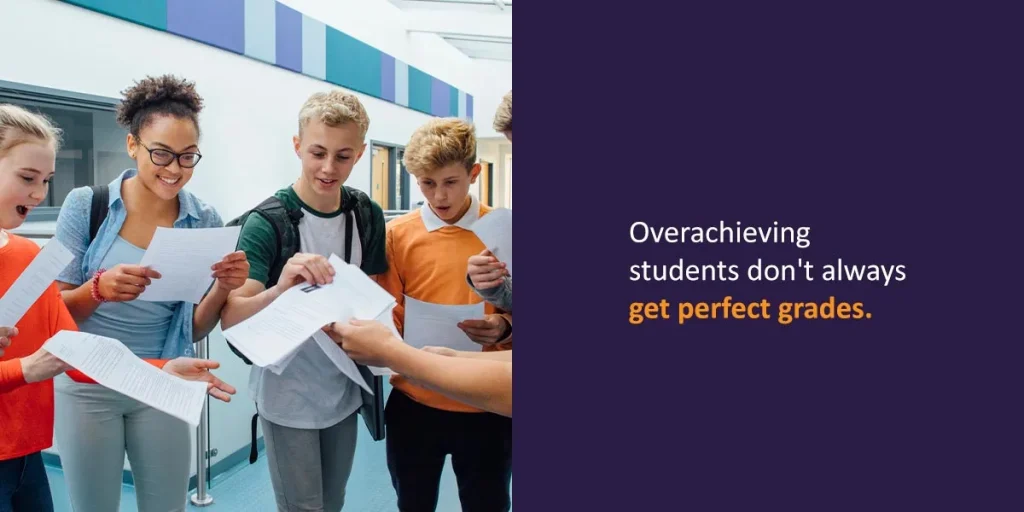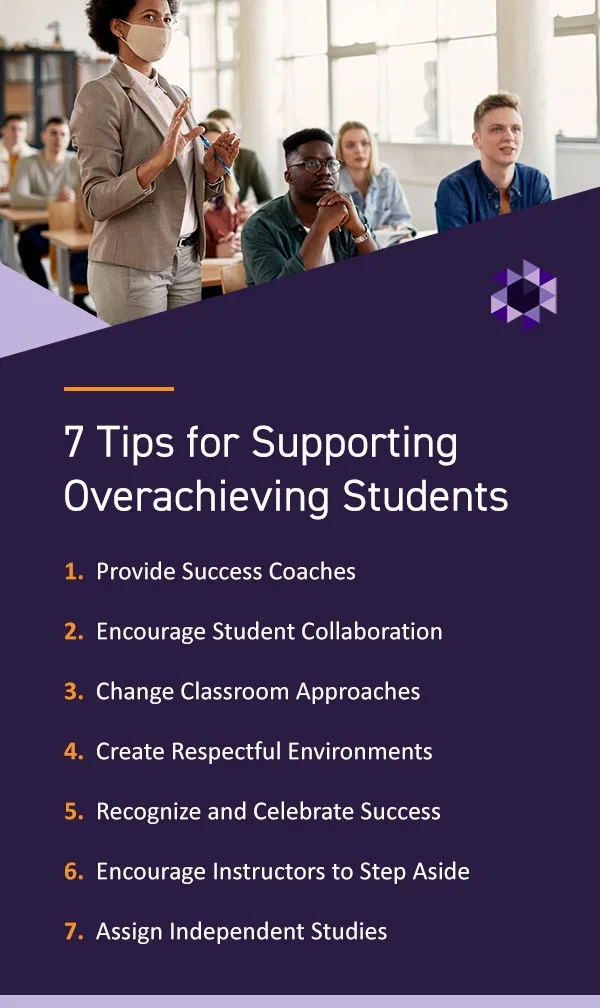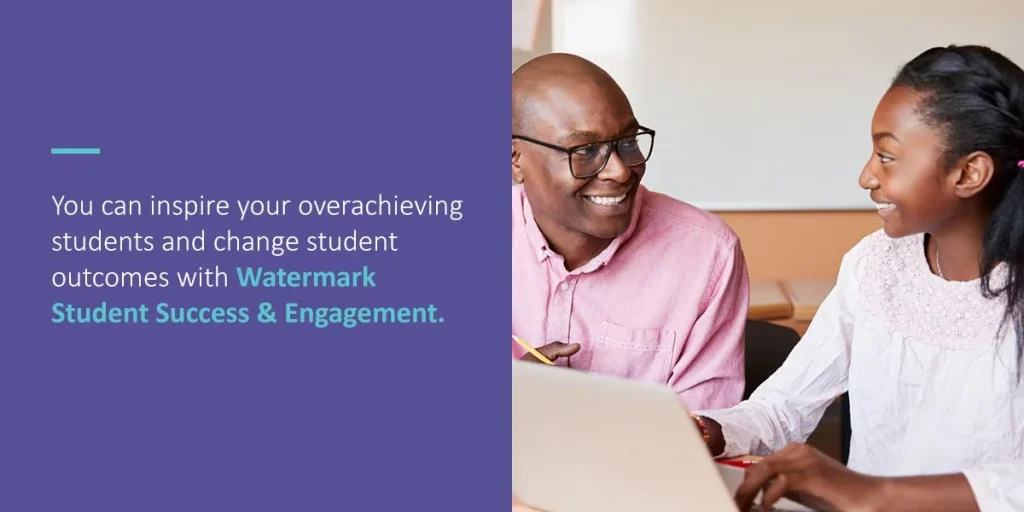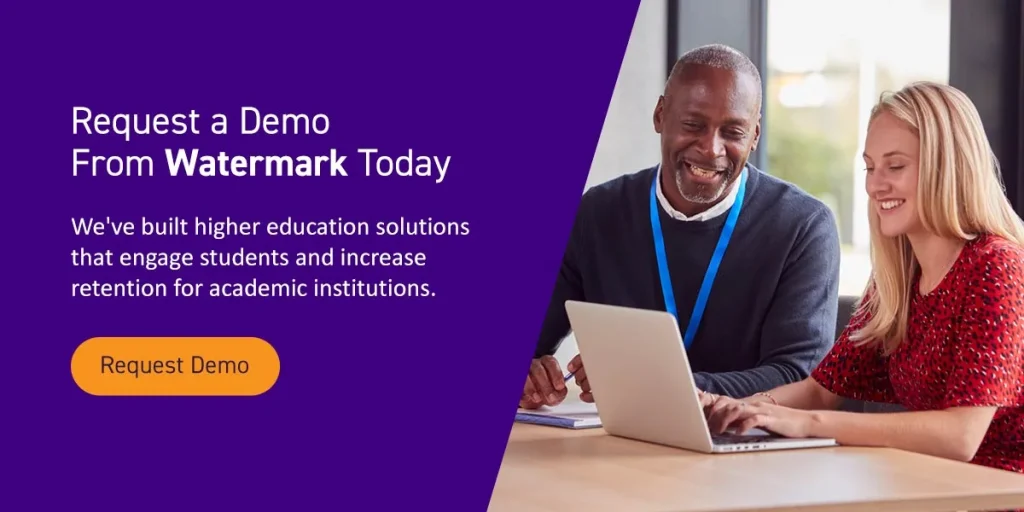



Supporting overachievers in higher education is critical to their educational experience. These students thrive in environments where they can better themselves and continue pursuing engaging materials that interest them. They want to feel challenged and recognize the importance of pushing their limits to see results and find opportunities.
Since high-achieving students tend to be self-directed, it’s easier to inspire them to perform their best. With the right success paths and connections with your students, they can seek challenges and seize opportunities that lead them to their goals and success.
Understanding and identifying your overachievers can help you recognize their needs and how to develop actionable steps that benefit them. After recognizing your high-achieving students, you can begin implementing various approaches to bring them closer to their education and help them thrive at your institution, while fostering their sense of lifelong learning.

Overachieving students don’t always get perfect grades. Though they do not want to fail, they understand the importance of seeking new opportunities and taking risks. They want to gain skills and refine the ones they currently have by partaking in new challenges. In higher education, these students may take high-level classes, load their course schedule, or withdraw from some classes or studies to pursue more exciting opportunities in another sphere.
Identifying overachievers and underachievers can help you implement strategies that encourage and benefit both. Overachievers focus on reaching their goals, while lower achievers set their sights on avoiding failure. High achievers understand the importance of pushing their limits and stepping outside their comfort zones, and how doing so can help them succeed and improve. Those who never test their boundaries usually experience average or below-average results when completing their tasks and goals.
Hallmarks of high-achiever students include the following.

Keeping your overachieving students engaged will help your student retention. Students with a genuine connection to their studies are more likely to have an enriching, rewarding, and enjoyable experience, while students who feel removed from their studies can have the opposite experience. If your students become detached and unchallenged, they may decide to seek opportunities at another institution or drop out of school altogether.
Inspiring overachievers can give them the academic experience they’re looking for. Guide them to success and motivate them to persevere through their degrees and programs. Offering your students resources and connections that can encourage and guide them will help you support their academic and individual needs.
Students looking for additional opportunities can benefit from having a mentor who guides them through challenges or gives them a more profound insight into research and projects with success coaching. Success coaching can provide students with direction and resources to reach academic and non-academic goals. With a holistic approach, success coaches can create individual experiences that support students’ ambitions, while recognizing the obstacles they face and how their unique circumstances affect their success.
Giving students a direct person to contact when they’re looking for new opportunities allows them to take a leading role in their education and success. Your institution can use personalized learning and holistic educational experiences to enrich students. Students can meet with their success coaches to discuss their academic track, including where they’ve excelled, problem areas, and how to continue working toward their goals. When an overachieving student asks for additional challenges, their success coach can equip them with the resources they need to do so.
Success coaches can also help lower-achieving students by discussing their plans, interests, and academic ambitions. These mentors can guide students toward classes that align with their career path and give them someone to reach out to when they struggle.
Student collaboration opens topics at a more complex level. If an assignment is effortless, students can complete it independently and won’t need to collaborate with their peers to produce quality work. Multilayered projects requiring communication and planning demand students to identify and overcome a problem together. This collaboration among students can spark discussion that drives research and debate as they share knowledge.
Peer mentors can also help each other reach success. Overachievers and underachievers alike can benefit from relationships with those in their classes. Having a high-achieving student collaborate and work with those who need additional help or resources encourages communication and a sense of group and individual accomplishment. Students who excel in one area can share their knowledge and expand their peers’ views while getting help in weaker subjects. Helping others also encourages positive self-talk and can help underachieving students experience the feelings of motivation that drive them toward better performance and reaching their goals.
Many students have spent years experiencing the same learning and teaching methods. Students looking for a challenge may benefit from a different classroom approach. Instead of instructors reviewing materials or giving a lecture and assigning work about the subject afterward, a flipped classroom can give your students more independence and encourage them to explore topics independently.
For example, instructors could assign work for students to complete at home before listening to a lecture, encouraging students to dive deeply into their materials and make connections they might not otherwise explore. As students encounter new problems and complex questions, they may need to research alternative methods to complete their assignments and uncover additional materials that the instructor does not present in class.
Creating an atmosphere where your students feel comfortable taking risks will encourage them to pursue new challenges. Many students stay silent in the classroom because they don’t want to speak up in front of an authority figure. Encouraging questions and debates and igniting mutually interesting conversations show students that instructors can be a source of challenges or opportunities, rather than intimidation.
Fostering a sense of mutual respect will encourage students to ask questions and initiate new conversations. Connecting with peers and instructors allows students to gain new perspectives and connect with different materials and questions. A respectful classroom where students and instructors allow each other to speak without interruption and spark tasteful debates can boost student confidence.
Additionally, clearly stating the importance of class discussion and involvement can bring more students to the forefront of academic conversations. Instead of lecturing for an entire class, instructors should encourage students to counter their arguments, bring new topics to light, and independently seek information to enlighten learners. High-achieving students who want to develop a more thorough academic connection may take the opportunity to lead discussions and involve other classmates in their findings.
Overachievers can sometimes set unrealistic expectations for themselves and fail as a result. Though overachievers can view failure as a learning experience, going too long without success can be disappointing and upsetting.
Recognizing and celebrating success can reinforce students’ enthusiasm to continue working toward their goals. Acknowledging accomplishments is an excellent way to encourage students to set realistic goals and reach success without stretching themselves too thin.
Instructors can recognize achievement in the classroom in many ways. Perhaps students who score above a specific percentage throughout the semester don’t have to complete the final examination, or an outstanding group project earns its members bonus points. Subtle and dramatic gestures of recognition can go a long way to show a student their hard work pays off and motivate them to keep doing their best.
Additionally, recognition can inspire lower-achieving students to push themselves academically. Students who may be doing the minimum to complete their programs may discover their initiative if they see hard work can allow them to accomplish their goals or make things easier on themselves in the future.
Allowing students to take the lead in their learning approach can keep them engrossed with their classes and materials. Instructors can back away from the blackboard and encourage students to take a leading role in providing innovative solutions and practice problem-solving in unique ways.
Rather than assigning traditional papers, instructors can encourage tiered learning. Allow students to choose how they want to present the information they’ve learned. For example, students discussing a work of literature could opt to deliver a presentation, write a traditional paper, give a speech to the class, or create a detailed project. Empowering learners to complete coursework at their preferred pace encourages students to work in the way that best suits their learning methods as they engage with the material.
These classroom environments can also encourage more student-instructor collaboration where students ask questions, feel more engaged, and seek alternative ways to understand complex topics. When students can explore independently, they may find additional information they want to learn more about in the future. Students can forge lasting connections with their instructors by asking questions during office hours and finding supplemental learning materials that prompt further discussion.
Engaging overachiever students can be challenging if they feel disconnected from the course materials. Students who think their coursework is uninspiring or unchallenging may withdraw from some coursework to focus on other, more interesting topics.
Encouraging more independent projects can keep your overachievers captivated as they pursue topics that interest them and allow them to dive as deeply as they feel is necessary. These projects can help students connect course materials with the additional information they’re finding by themselves and uncover new value for a subject. Whether your students are interested in pursuing an entirely new topic or investigating the nitty-gritty details of a class concept, an independent project or study can give them the additional push they need to stay engaged.
Instructors can further encourage a profound connection between students and their work by prompting them to apply their studies to a larger picture. Students can use their findings to improve their institution, connect with their community, or create a new program their school lacks.

Learning is a lifelong process, and education spans far beyond the work students complete in the classroom. You can inspire your overachieving students and change student outcomes with Watermark Student Success & Engagement.
Watermark Student Success & Engagement is a higher education solution to keep students motivated, track trends, and increase retention. This software can help you identify which students need your attention and provide solutions to get them back on track. Our software turns insights into actionable data you can use to collaborate with your students.
Along with receiving alerts to notify you when a student falls behind, you can easily connect with students and change success strategies to create a completely individual academic approach. You can effortlessly make and keep appointments, monitor attendance, and support students throughout their educational journey.
Encourage your overachievers and support lower achievers from Day One, keeping your students engaged and on track to complete their degrees or programs on time or at their preferred pace. Watermark Student Success & Engagement makes it simpler to meet your students’ needs and inspire them to push past their perceived limits.

Watermark delivers insights that inspire progress. We’ve built higher education solutions that engage students and increase retention for academic institutions. We want to evolve and empower student success, and we’ve developed software that makes this possible and easy to implement.
Watermark Student Success & Engagement can help you make a difference for your students. With the ability to streamline data, you can track student performance and achievement trends and develop success plans that work for them and your institution.
Students can interact with their peers and easily communicate during group projects or casual get-togethers, fostering a sense of community and belonging while prompting intellectual discussion. They can reach out to their success team at any time to seek additional challenges or uncover resources to guide them through their studies, and you can create stimulating environments to keep your students on track for program and degree completion.
Encouraging overachievers to keep striving toward their goals can be easy. Request a demo of Watermark Student Success & Engagement and continue guiding your overachievers down their paths to success.





























































































































































































































































































































































































